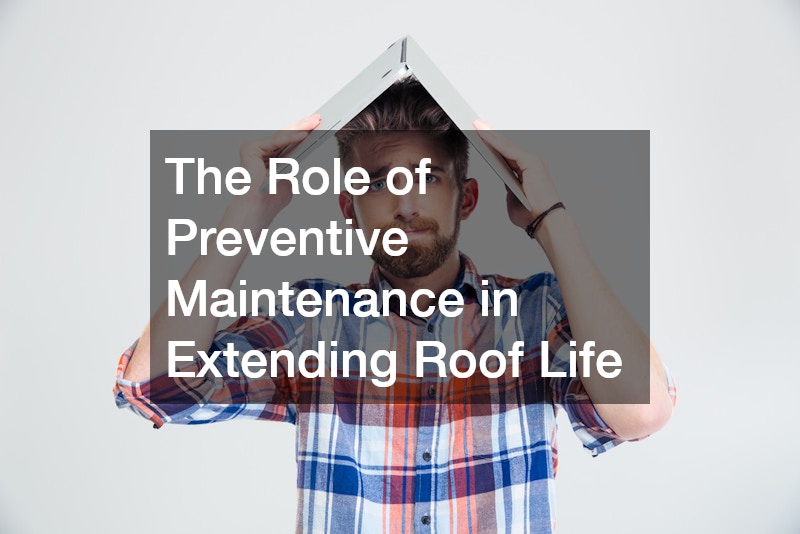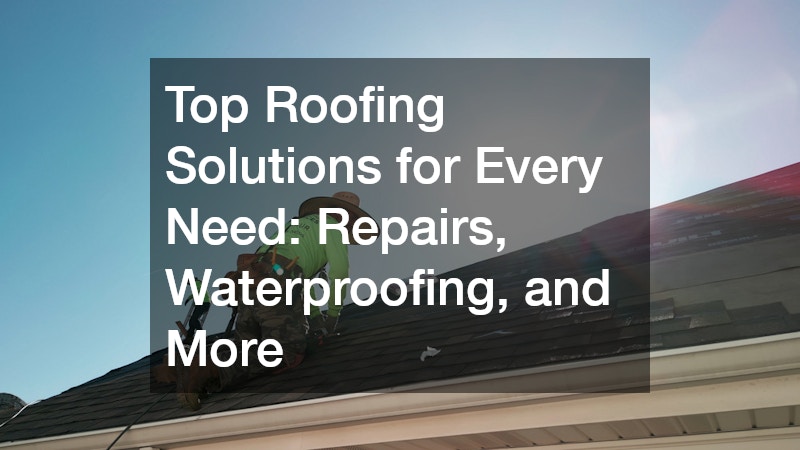A strong, reliable roof is one of the most important parts of any home or business. It protects everything beneath it from harsh weather, helps regulate indoor temperature, and adds aesthetic appeal and property value. Yet despite its importance, the roof is often the most neglected system in a building. Many people assume that if it’s not leaking, it’s fine — until a sudden storm, aging materials, or poor drainage prove otherwise.
Your roofing system is constantly at work: enduring rain, snow, sunlight, wind, and debris. Each of those elements wears it down in different ways. The good news? With the right knowledge, professional help, and maintenance habits, you can prevent most roof issues long before they become expensive emergencies.
This guide explores the top roofing solutions for every need — from small repairs to large replacements, waterproofing systems, and maintenance tips. Whether you’re a homeowner hoping to preserve your investment or a business owner managing multiple properties, you’ll find practical insights here for keeping your roof in top condition year-round.
Understanding When Your Roof Needs Attention

Your roof doesn’t fail overnight; it sends warning signs first. The trick is recognizing them early enough to take action. A single cracked shingle or minor leak can quickly escalate into water intrusion, structural damage, or even mold growth if ignored.
Key Indicators of Roof Problems
-
Water stains or bubbling paint on ceilings or upper walls
-
Missing or damaged shingles after a storm
-
Moss, algae, or lichen growth, which can trap moisture and deteriorate materials
-
Sagging rooflines, often indicating structural weakness
-
Sudden spikes in energy bills due to insulation or ventilation issues
Even subtle changes—like curling shingles or dark streaks—can signal trouble. Scheduling an inspection with a roofing specialist ensures a trained eye examines the entire surface, flashing, vents, and gutters for hidden problems. A professional roofer knows how to safely walk roofs, check for soft spots, and use moisture meters or drones to assess hard-to-reach areas.
Being proactive can extend a roof’s life by years. Consider setting calendar reminders for seasonal visual inspections and professional checkups each spring and fall. Prevention truly costs a fraction of repair.
Making the Right Choice Between Repair and Replacement
When your roof starts showing wear, one of the biggest questions is whether to repair or replace it. While patching a leak might seem cheaper, sometimes replacement is the smarter long-term decision — especially if your roof’s structure or age are working against you.
How to Decide
-
Evaluate the roof’s age: Asphalt shingles last around 20–25 years; metal roofs can last 40–70 years.
-
Consider the damage pattern: Localized issues (like a fallen branch) may be fixed, but widespread wear signals the need for replacement.
-
Check your home’s structure: Rotted decking or sagging joists indicate underlying issues beyond surface repair.
-
Compare costs: If repair costs exceed 30% of a new roof’s price, replacement is often more practical.
Request a detailed roof estimate from multiple contractors before making your decision. These estimates should include materials, labor, disposal, and warranty coverage. Sometimes, investing in roof replacements adds instant resale value while reducing ongoing maintenance.
Think of it as upgrading the “skin” of your house — improving insulation, curb appeal, and protection all at once.
Handling Urgent Damage Quickly and Safely
Storms don’t wait for business hours, and neither do roof problems. High winds, falling trees, or heavy snow can leave holes or leaks that need immediate attention. In these moments, quick thinking prevents water from spreading through walls or insulation.
What to Do First
-
Stay calm and stay off the roof. Wet or damaged surfaces are slippery and unsafe.
-
Protect your interior. Use buckets, towels, or plastic sheeting to contain water and prevent ceiling collapse.
-
Document everything. Take pictures and videos for insurance claims.
-
Temporarily cover the damage. A waterproof tarp secured with weights or screws can minimize further leakage.
Then, contact professionals who specialize in emergency roof repairs. They can secure the area, dry it out, and assess whether structural damage occurred. Once the crisis is stabilized, hire a local roof repair service for permanent restoration.
Local contractors are familiar with your region’s weather patterns, permitting requirements, and available materials — which means faster, more reliable service when every hour counts.
The Role of Preventive Maintenance in Extending Roof Life

Preventive maintenance is one of the most overlooked yet valuable roofing investments. Homeowners often assume that roofs are “set and forget,” but even the best materials need care. A consistent maintenance plan keeps your roof healthy, prevents leaks, and ensures small issues don’t escalate.
What Regular Roof Maintenance Should Include
-
Cleaning gutters and downspouts: Clogged gutters cause water to pool, leading to leaks or rot.
-
Trimming overhanging trees: Prevents branches from scraping shingles and dropping debris.
-
Checking flashing: This thin metal layer seals joints and edges — it’s often the first place leaks appear.
-
Inspecting ventilation: Poor airflow traps heat and moisture, shortening shingle life.
-
Washing roof surfaces: Professional roof cleaners can safely remove algae, moss, and mildew without damaging materials.
A roofing specialist can build a personalized maintenance schedule based on your roof type and environment. For example, homes in coastal regions face salt corrosion, while those under dense trees require more frequent debris removal.
Regular maintenance isn’t just about durability — it’s about peace of mind. You’ll sleep better knowing your roof is ready for whatever weather comes next.
Weatherproofing Strategies That Work Year-Round
Rain, humidity, snow, and heat are all relentless enemies of roofing materials. Weatherproofing creates a barrier that resists leaks and temperature extremes, adding years of protection to your roof.
Common Waterproofing Methods
-
Rubberized membranes: Ideal for flat or low-slope roofs, these create a continuous watertight layer.
-
Elastomeric coatings: These thick, flexible coatings reflect UV rays and expand or contract with temperature changes.
-
Sealant applications: Targeted sealants reinforce vulnerable areas like chimneys, skylights, and vents.
-
Upgraded underlayment: Modern synthetic materials resist tearing and moisture far better than old asphalt felt.
If you’re unsure what’s best for your roof, consult a local waterproofing contractor who understands regional weather trends and building codes.
Houses with specialty roofs—like copper, tile, or living green roofs—require customized waterproofing solutions. For instance, a copper roof may need special sealants to avoid corrosion, while a green roof must include layered membranes and proper drainage. Proper waterproofing protects not only the structure but also your home’s energy efficiency, reducing both heat loss in winter and heat gain in summer.
Choosing the Right Materials for Durability and Style
The material you choose affects every aspect of roof performance: cost, lifespan, maintenance, and even resale value. A well-chosen roof complements the home’s design while withstanding your region’s weather challenges.
Material Options and What They Offer
-
Asphalt shingles: Affordable, available in multiple colors, and easy to replace. Lifespan: 20–25 years.
-
Metal roofing: Excellent for heavy snow or rain regions. Reflects sunlight and lasts up to 70 years.
-
Wood shakes: Beautiful and natural, but require consistent maintenance to prevent rot.
-
Slate or clay tiles: Elegant and durable, though heavy and expensive to install.
-
Synthetic materials: Designed to mimic slate or tile but lighter and more affordable.
Your roofer will help balance beauty, durability, and budget. Always consider local factors: high winds, snow load, salt air, or extreme temperatures.
Owners of specialty roofs—like copper domes or solar tile systems—should seek contractors with proven experience installing and maintaining those specific materials. Specialized designs deliver incredible longevity when cared for correctly.
Roofing for Businesses: Meeting Unique Commercial Needs

Commercial roofing is a world apart from residential systems. These roofs often span thousands of square feet, support HVAC equipment, and use materials designed for function over form.
Key Considerations for Business Owners
-
Flat or low-slope design: Requires careful drainage planning to avoid pooling water.
-
Material durability: PVC and TPO membranes are top choices for weather resistance and energy efficiency.
-
Maintenance access: Ensure walkways and safety rails allow technicians to access rooftop units.
-
Energy performance: Reflective coatings and insulation can significantly reduce operational costs.
Partnering with a trusted commercial roofing service ensures compliance with OSHA standards and manufacturer warranties. Many providers also offer scheduled inspections that include infrared scanning to detect leaks invisible to the eye.
When upgrades are needed, combining roof replacements with insulation or solar installations can turn your roof into an energy-saving asset — something modern tenants and customers increasingly value.
Protecting Your Investment With Regular Inspections
Even a small roof problem can lead to major expenses if ignored. Regular inspections are like an annual physical for your property — they catch hidden issues before they worsen.
How to Get the Most from Roof Inspections
-
Schedule biannual inspections: Once before winter and once after severe weather seasons.
-
Use drones or infrared technology: Many pros now offer advanced imaging to detect trapped moisture.
-
Request a full written report: It should detail current issues, risk levels, and recommended actions.
-
Keep all documentation: Inspection reports and receipts can help with warranty and insurance claims later.
After each inspection, ask for a transparent roof estimate outlining repair costs and timelines. Establishing an ongoing relationship with a local roof repair team ensures they know your property’s quirks and history. That familiarity allows them to track changes year over year and make data-driven recommendations.
A consistent inspection routine doesn’t just prevent emergencies — it builds a record of stewardship that adds value to your property.
Hiring the Right Professionals for the Job
Choosing the right contractor determines how well your roof performs for decades. The roofing industry has its share of excellent experts and, unfortunately, a few unreliable operators. Doing your homework upfront prevents regret later.
Checklist for Hiring a Contractor
-
Verify licensing and insurance: Never work with an unlicensed roofer.
-
Ask for references: Reliable contractors can provide examples of similar completed projects.
-
Compare detailed quotes: Low bids can signal shortcuts in materials or labor.
-
Check communication style: Clear explanations and prompt replies are good signs.
-
Confirm warranties: Understand who is responsible if materials fail or workmanship issues arise.
A trustworthy roofing specialist should focus on educating you — not pressuring you. They’ll explain material options, show examples, and help you make informed choices. For projects that involve waterproofing or sealing, coordinating with a local waterproofing contractor ensures no gap between roof integrity and water protection systems.
Quality roofing work doesn’t just look good — it performs beautifully under stress. Choose experts who see your project as a partnership, not just a transaction.
Enhancing Energy Efficiency Through Smart Roofing Choices

Modern roofing solutions do more than protect your home; they also help you save on energy bills. Whether you’re upgrading old materials or designing a new structure, energy-smart decisions pay off immediately and long-term.
Energy-Saving Roofing Strategies
-
Cool roofs: Use reflective coatings or lighter-colored materials to reduce heat absorption.
-
Ventilation systems: Proper airflow prevents heat buildup in summer and moisture accumulation in winter.
-
Attic insulation: Strengthens thermal regulation and supports roof health by controlling temperature extremes.
-
Solar integration: Pairing panels with suitable underlayment during roof replacements ensures seamless performance.
-
Reflective membranes for flat roofs: For commercial spaces, these drastically lower HVAC costs.
Partner with a commercial roofing service or residential contractor familiar with energy-efficient building codes. The right materials and installation techniques can lower energy bills by 15–25%, while extending the life of both your roof and your HVAC system.
Sustainable roofing isn’t just about being eco-friendly — it’s about investing in comfort, durability, and financial efficiency.
In conclusion, a roof is much more than a layer of shingles — it’s your home’s shield, your business’s protector, and your property’s most important asset. From minor fixes to full-scale replacements, every roofing decision has lasting consequences for comfort, safety, and cost.
By learning the signs of roof damage, scheduling consistent inspections, and partnering with qualified professionals, you can stay ahead of problems rather than react to them. Whether you’re sealing out moisture, upgrading materials, or enhancing energy efficiency, the key to success is simple: act early, maintain regularly, and choose experts who care about long-term performance.
Your roof has one job — to protect what matters most. Give it the attention, maintenance, and expertise it deserves, and it will return the favor for decades to come.
